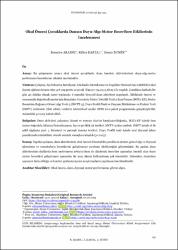Okul Öncesi Çocuklarda Dansın Duyu-Algı-Motor Becerilere Etkilerinin İncelenmesi
Özet
Amaç: Bu çalışmanın amacı okul öncesi çocuklarda dans hareket aktivitelerinin duyu-algı-motor
performans becerilerine etkisini incelemektir.
Yöntem: Çalışma, Zeytinburnu Belediyesi, Aile Kadın Destekleme ve Engelliler Merkezi’nde (AKDEM) okul
öncesi eğitime devam eden 4-6 yaş grubu 12 çocuk (Yaş ort: 59,25±5,86 ay) ile yapıldı. Çocuklara haftada bir
gün 40 dakika olmak üzere toplamda 6 seanslık bireysel dans aktivitesi uygulandı. Müdahale öncesi ve
sonrasında değerlendirmeler için Bruininks-Oseretsky Motor Yeterlik Testi 2 Kısa Formu (BOT2-KF), Motor
Beceriden Bağımsız Görsel Algı Testi-3 (MVPT-3), Duyu Profili Testi ve Duyusal Bütünleme ve Praksis Testi
(DBPT) kullanıldı. Elde edilen verilerin istatistiksel analizi SPSS 22.0 paket programında gerçekleştirildi.
Anlamlılık p<0,05 kabul edildi.
Bulgular: Dans aktivitesi çalışması öncesi ve sonrası skorlar karşılaştırıldığında, BOT2-KF içinde ince
motor doğruluk, bilateral koordinasyon, hız ve çeviklik alt testleri; MVPT-3 tüm testleri; DBPT içinde el ile
şekil algılama part 1, kinestezi ve parmak tanıma testleri; Duyu Profili testi içinde oral duyusal işlem
puanlarında istatistiksel olarak anlamlı sonuçlara ulaşıldı (p<0,05).
Sonuç: Yapılan çalışma, dans aktivitesinin okul öncesi dönemdeki çocukların motor, görsel algı ve duyusal
işlemleme ve somatoduyu becerilerini geliştirmeye yardımcı olabileceğini göstermiştir. Bu açıdan dans
aktivitesinin okullarda hem motivasyon arttırıcı hem de akademik beceriler açısından önemli olan duyu
motor becerileri geliştirmesi açısından bir araç olarak kullanılması çok önemlidir. Gelecekte, örneklem
sayısının fazla olduğu ve kontrol grubunu içeren araştırmaların yapılması önerilmektedir. Aim: The aim of this study is to examine the effects of dance movement activities on sensory-perceptionmotor performance skills in preschool children.
Method: The study was applied to 12 children aged 4-6 (Mean age:59,25±5,86 months) who continue to a
pre-school education group at Zeytinburnu Municipality, Family Women Support and Disabled Center
(AKDEM). A total of 6 sessions of individual dance lessons were applied to the children for 40 minutes once
a week. Bruininks-Oseretsky Motor Proficiency Test 2 Short Form (BOT2-SF), Motor Free Visual Perception
Test-3 (MVPT-3), Sensory Profile Test and Sensory Integration and Praxis Test (SIPT) were used for pre and
post-intervention evaluations. The SPSS 22.0 program was used for statistical analysis. p<0.05 was
considered significant.
Results: When the scores before and after the dance activity study were compared; fine motor accuracy,
bilateral coordination, speed and agility subtests of BOT2-SF; all subtests of the MVPT-3; in the SIPT manual
shape perception part 1, kinesthesia and finger identification tests; in the Sensory Profile Test oral sensory
processing scores, statistically significant results were obtained (p<0.05).
Conclusion: The study showed that dance activity can help preschool children develop motor, visual
perception and sensory processing and somatosensory skills.In this respect, it is very important to use dance
activity in schools as a tool to both increase motivation and improve skills. In the future, it is recommended
to carry out studies with a large number of samples and a control group.
Sayı
20Bağlantı
https://hdl.handle.net/11363/5507Koleksiyonlar
Aşağıdaki lisans dosyası bu öğe ile ilişkilidir:


















